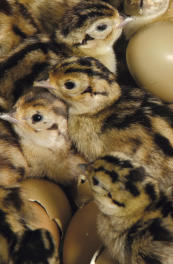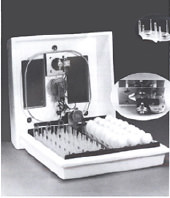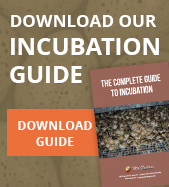Basic Guidelines for Small Incubators
Ben Lawton - [email protected]
One of the jobs as a manager here at MacFarlane Pheasants is to answer questions that our customers have regarding the gamebird business. Whether it be incubation, brooding or any other area of concern, we like to help in any way we can. As the Hatchery Manager of what is considered one of the largest hatcheries of pheasants in the nation, I get my share of calls.
regarding the gamebird business. Whether it be incubation, brooding or any other area of concern, we like to help in any way we can. As the Hatchery Manager of what is considered one of the largest hatcheries of pheasants in the nation, I get my share of calls.
Recently there has been a great increase in calls regarding small hobby incubators and their operation. These units usually hold anywhere from 10-30 eggs and are popular with school classes and poultry hobbyists. Since our smallest setter holds 21,000+ eggs, I can’t say I am an expert in the operation of these smaller units. Yet, in all types of incubators, certain guidelines are universal.
The most important rules are:
Rule 1) Read and follow the manufacturer’s recommendations. If there are problems from the start, then you can begin to explore the reasons for the poor hatch with a logical approach.
Rule 2) Egg handling prior to setting, temperature, turning, humidity and venting are the five major areas of concern.
Don’t hold eggs too long or at the wrong temperature (58° for up to 10 days) before setting.
Have at least two thermometers that measure up to .1 degree mark if possible and check often. Temperatures can vary in these units quite widely from one spot to another. A temperature of 99-99.4° is best for pheasants. Lower temperature if possible to 98° at 21 days.
Many small units have auto turner systems now. Make sure the egg turns at least 90° five times per day. Auto turners usually hold the egg upright, so make sure the large end is up.
If turning manually, mark one side of the egg with an ‘X” and the other with an ‘O’. Turn the eggs an odd number of times during the day so they don’t end up on the same side overnight every time.
Stop turning the eggs after 21 days.
 Humidity is usually provided in the form of a small water pan or trough. Keep these full. You do not need to spray additional H2O into the unit unless there is no other source of humidity. Don’t wet the eggs.
Humidity is usually provided in the form of a small water pan or trough. Keep these full. You do not need to spray additional H2O into the unit unless there is no other source of humidity. Don’t wet the eggs.
Ventilation in these units usually consists of small holes that can be plugged or opened to varying degrees. Try keeping the ventilation closed the first three days, then give more ventilation as the incubation proceeds. During the last four days, maximum ventilation will be needed to supply the fully developed embryos with the air exchange they need.
Pay attention to these simple rules and most small incubators will do a fine job of hatching pheasant eggs.
If problems do occur, break the eggs out after the 26th day and make observations on stage of development and condition of the unhatched embryo if present at all. Then if you can’t determine the problem yourself, give me a call.
